Chromite Composition and Platinum-Group Elements Distribution in Tethyan Chromitites of the Mediterranean Basin: An Overview
Abstract
:1. Introduction
2. Geological Background and Chromitite Description of Tethyan Ophiolites in the Mediterranean Basin
2.1. The Chromitites of Italy and Their Host Ophiolites
2.2. The Chromitites of Albania and Their Host Ophiolites
2.3. The Chromitites of Serbia and Kosovo and Their Host Ophiolites
2.4. The Chromitites of Greece and Their Host Ophiolites
2.4.1. The Pindos–Olonos Zone Chromitites
2.4.2. The Pelagonian Zone Chromitites
2.4.3. The Circum-Rhodope Belt, Serbo-Macedonian, and Rhodope Massif Chromitites
2.5. The Chromitites of Turkey and Their Host Ophiolites
2.5.1. The Taurides Belt Chromitites
2.5.2. The Pontides Belt Chromitites
2.5.3. The Anatolides Belt Chromitites
2.5.4. The Arabian Platform Chromitites
2.6. The Chromitites of Cyprus and Their Host Ophiolite
3. Distribution of High-Al and High-Cr Chromitites in Ophiolitic Complexes
4. Distribution of PGE in Chromitites
4.1. PGE Distribution in the Chromitites of Italy
4.2. PGE Distribution in the Chromitites of Albania
4.3. PGE Distribution in the Chromitites of Serbia and Kosovo
4.4. PGE Distribution in the Chromitites of Greece
4.5. PGE Distribution in the Chromitites of Turkey
4.6. PGE Distribution in the Chromitites of Cyprus
5. Comparative Analysis of PGE Content in High-Al and High-Cr Chromitites
6. Discussion
6.1. Significance of the Distribution of the High-Al and High-Cr Chromitites
6.2. The Relation between the Chromite Composition and the PGE Distribution
7. Summary and Conclusions
Supplementary Materials
Author Contributions
Funding
Data Availability Statement
Acknowledgments
Conflicts of Interest
References
- Arai, S. Genetic Link between Podiform Chromitites in the Mantle and Stratiform Chromitites in the Crust: A Hypothesis. Minerals 2021, 11, 209. [Google Scholar] [CrossRef]
- Naldrett, A.J.; Kinnaird, J.; Wilson, A.; Yudovskaya, M.; McQuade, S.; Chunnett, G.; Stanley, C. Chromite composition and PGE content of Bushveld chromitites: Part 1—The Lower and Middle Groups. Trans. Inst. Min. Metal. B Appl. Earth Sci. 2009, 118, 131–161. [Google Scholar] [CrossRef]
- Mosier, D.L.; Singer, D.A.; Moring, B.C.; Galloway, J.P. Podiform chromite deposits—Database and grade and tonnage models. US Geol. Surv. Sci. Investig. Rep. 2012, 5157, 54. [Google Scholar]
- Cawthorn, R.G. The Platinum Group Element Deposits of the Bushveld Complex in South Africa. Platin. Met. Rev. 2010, 54, 205–215. [Google Scholar] [CrossRef]
- Dilek, Y.; Furnes, H.; Shallo, M. Suprasubduction zone ophiolite formation along the periphery of Mesozoic Gondwana. Gond. Res. 2007, 11, 453–475. [Google Scholar] [CrossRef]
- Robertson, A.H.F. Overview of the genesis and emplacment of Mesozoic ophiolites in the Eastern Mediterranean Tethyan region. Lithos 2002, 65, 1–67. [Google Scholar] [CrossRef]
- Dilek, Y.; Furnes, H. Structure and geochemistry of Tethyan ophiolites and their petrogenesis in subduction rollback systems. Lithos 2009, 113, 1–20. [Google Scholar] [CrossRef]
- Dilek, Y.; Furnes, H. Ophiolite genesis and global tectonics: Geochemical and tectonic fingerprinting of ancient oceanic lithosphere. Geol. Soc. Am. Bull. 2011, 123, 387–411. [Google Scholar] [CrossRef]
- Zhou, M.-F.; Robinson, P. Origin and tectonic environment of podiform chromite deposits. Econ. Geol. 1997, 92, 259–262. [Google Scholar] [CrossRef]
- Zhou, M.-F.; Sun, M.; Keays, R.R.; Kerrich, R.W. Controls on platinum-group elemental distributions of podiform chromitites: A case study of high-Cr and high-Al chromitites from Chinese orogenic belts. Geochim. Cosmochim. Acta 1998, 62, 677–688. [Google Scholar] [CrossRef]
- Zhou, M.-F.; Robinson, P.T.; Malpas, J.; Aitchison, J.; Sun, M.; Baj, W.J.; Hu, X.F.; Yang, J.S. Melt/mantle interaction and melt evolution in the Sartohay high-Al chromite deposits of the Dalabute ophiolite (NW China). J. Asian Earth Sci. 2001, 19, 517–534. [Google Scholar] [CrossRef]
- Economou-Eliopoulos, M.; Tsoupas, G.; Kiousis, G. Exploration for platinum-group elements (PGE) in various geotectonic settings of Greece. J. Virt. Expl. 2013, 45, 65–82. [Google Scholar]
- Zaccarini, F.; Economou-Eliopoulos, M.; Kiseleva, O.; Garuti, G.; Tsikouras, B.; Pushkarev, E.; Idrus, A. Platinum Group Elements (PGE) Geochemistry and Mineralogy of Low Economic Potential (Rh-Pt-Pd)-Rich Chromitites from Ophiolite Complexes. Minerals 2022, 12, 1565. [Google Scholar] [CrossRef]
- Moores, E.M. Origin and emplacement of ophiolites. Rev. Geophys. 1982, 20, 735–760. [Google Scholar] [CrossRef]
- Bortolotti, V.; Chiari, M.; Marcucci, M.; Marroni, M.; Pandolfi, L.; Principi, G.; Saccani, E. Comparison among the Albanian and Greek ophiolites: In search of constraints for the evolution of the mesozoic Tethys ocean. Ofioliti 2004, 29, 19–35. [Google Scholar]
- Cortesogno, L.; Galbiati, B.; Principi, G. Note alla “Carta geologica delle ofioliti del Bracco” e ricostruzione della paleogeografia Giurassico, Cretacica. Ofioliti 1987, 12, 261–342. [Google Scholar]
- Jacobshagen, V.; Durr, S.; Kockel, F.; Kopp, K.O.; Kowalczyk, G. Structure and geodynamic evolution of the Aegean region. In Alps, Apennines, Hellenides; Closs, H., Roeder, D., Schmidt, K., Eds.; Schweizerbart: Stuttgart, Germany, 1978; pp. 537–564. [Google Scholar]
- Ketin, İ. Tectonic units of Anatolia (Asia Minor). Bull. Mineral Res. Expl. Inst. Turkey 1966, 66, 24–37. [Google Scholar]
- Parlak, O.; Delaloye, M. Precise 40Ar/39Ar ages from the metamorphic sole of the Mersin ophiolite (southern Turkey). Tectonophysics 1999, 301, 145–158. [Google Scholar] [CrossRef]
- Hoeck, V.; Koller, F.; Meisel, T.; Onuzi, K.; Kneringer, E. The Jurassic South Albanian ophiolites: MOR- vs. SSZ-type ophiolites. Lithos 1992, 65, 143–164. [Google Scholar] [CrossRef]
- Baumgartner, R.J.; Zaccarini, F.; Garuti, G.; Thalhammer, O.A.R. Mineralogical and geochemical investigation of layered chromitites from the Bracco-Gabbro complex, Ligurian ophiolite, Italy. Cont. Mineral. Petrol. 2013, 165, 477–493. [Google Scholar] [CrossRef]
- Çina, A.; Caslli, H.; Goci, L. Chromites in the ophiolites of Albanides. In Cromite; Petrascheck, W., Karamata, S., Kravchenko, G.G., Johan, J., Economou, M., Engin, T., Eds.; Theophrastus Publication: Athens, Greece, 1986; pp. 107–128. [Google Scholar]
- Çina, A.; Neziraj, A.; Karaj, N.; Johan, Z.; Ohnenstetter, M. PGE mineralization related to Albanian ophiolitic complex. Geol. Carpat. 2002, 53, 1–7. [Google Scholar]
- Çina, A. (Ed.) On Mineralogy and Metallogeny of Albanides; Polytechnic University of Albania: Tirana, Albania, 2014; pp. 3–478. ISBN 978-9928-181-12-1. [Google Scholar]
- Economou, G.; Economou, M. Some chromite occurrences from the areas of Vermio and Veria, Macedonia, Greece. In Metallogeny of Basic and Ultrabasic Rocks; Gallagher, M.J., Ixer, R.A., Neary, C.R., Prichard, H.M., Eds.; Institution of Mining and Metallurgy: London, UK, 1986; pp. 351–354. [Google Scholar]
- Economou, M.; Dimou, E.; Economou, D.; Migiros, G.; Vacondios, I.; Grivas, E.; Rassios, A.; Dabitzias, S. Chromite deposits of Greece. In Cromite; Petrascheck, W., Karamata, S., Kravchenko, G.G., Johan, J., Economou, M., Engin, T., Eds.; Theophrastus Publication: Athens, Greece, 1986; pp. 129–159. [Google Scholar]
- Engin, T.; Özkoçak, O.; Artan, U. General geological setting and character of chromite deposits in Turkey. In Cromite; Petrascheck, W., Karamata, S., Kravchenko, G.G., Johan, J., Economou, M., Engin, T., Eds.; Theophrastus Publication: Athens, Greece, 1986; pp. 199–228. [Google Scholar]
- Jankovic, S.; Karamata, S. The chromite deposits of the NE Mediterranean: Principal morpho-structural features and genetic implications. In Cromite; Petrascheck, W., Karamata, S., Kravchenko, G.G., Johan, J., Economou, M., Engin, T., Eds.; Theophrastus Publication: Athens, Greece, 1986; pp. 45–66. [Google Scholar]
- Jankovic, S. General features of chromite deposits and major ore district in Yugoslavia. In Cromite; Petrascheck, W., Karamata, S., Kravchenko, G.G., Johan, J., Economou, M., Engin, T., Eds.; Theophrastus Publication: Athens, Greece, 1986; pp. 67–89. [Google Scholar]
- Obradovic, L.J. On the chemistry of chromitites from Bregoviza, Sara Mountain, Yugoslavia. In Cromite; Petrascheck, W., Karamata, S., Kravchenko, G.G., Johan, J., Economou, M., Engin, T., Eds.; Theophrastus Publication: Athens, Greece, 1986; pp. 91–105. [Google Scholar]
- Panayiotou, A.; Michaelides, A.E.; Georgiou, E. The chromite deposits of the Troodos ophiolite complex, Cyprus. In Cromite; Petrascheck, W., Karamata, S., Kravchenko, G.G., Johan, J., Economou, M., Engin, T., Eds.; Theophrastus Publication: Athens, Greece, 1986; pp. 161–198. [Google Scholar]
- Economou-Eliopoulos, M. Platinum-group element (PGE) distribution in chromite ores from ophiolite complexes of Greece: Implications for chromite exploration. Ofioliti 1993, 18, 83–97. [Google Scholar]
- Economou-Eliopoulos, M.; Eliopoulos, D. Significance of a spatial association of high-Cr and high-Al chromitites for their genesis and exploration. Bull. T. CXIX Acad. Serbe Sci. Arts 1999, 39, 127–140. [Google Scholar]
- Economou-Eliopoulos, M. Platinum-group element distribution in chromite ores from ophiolite complexes: Implications for their exploration. Ore Geol. Rev. 1996, 11, 363–381. [Google Scholar] [CrossRef]
- Beqiraj, A.; Masi, U.; Violo, M. Geochemical characterization of podiform chromite ores from the ultramafic massif of Bulqiza (Eastern Ophiolitic Belt, Albania) and hints for exploration. Explor. Min. Geol. 2000, 9, 149–156. [Google Scholar] [CrossRef]
- Tashko, A.; Economou-Eliopoulos, M.; Economou, G. An overview of the PGE distribution in the Bulquiza ophiolite complex, Albania. Bull. Geol. Soc. Greece 1998, 32, 193–201. [Google Scholar]
- Qiu, T.; Yang, J.; Milushi, I.; Wu, W.; Mekshiqi, N.; Xiong, F.; Zhang, C.; Shen, T. Petrogenesis and PGE Abundances of High-Cr and High-Al Chromitites and Peridotites from the Bulqiza Ultramafic Massif, Eastern Mirdita Ophiolite, Albania. Acta Geol. Sin. Engl. Ed. 2018, 93, 25. [Google Scholar] [CrossRef]
- Kocks, H.; Melcher, F.; Meisel, T.; Burgath, K.-P. Diverse contributing sources to chromitite petrogenesis in the Shebenik Ophiolitic Complex, Albania: Evidence from new PGE- and Os-isotope data. Mineral. Petrol. 2007, 91, 139–170. [Google Scholar] [CrossRef]
- Economou, M. Platinum-group elements (PGE) in chromite and sulfide ores related with ophiolites. Metallogeny of Basic and Ultrabasic Rocks. In Metallogeny of Basic and Ultrabasic Rocks; Gallagher, M.J., Ixer, R.A., Neary, C.R., Prichard, H.M., Eds.; Institution of Mining and Metallurgy: London, UK, 1986; pp. 441–453. [Google Scholar]
- Economou-Eliopoulos, M.; Vacondios, I. Geochemistry of chromitites and host rocks from the Pindos ophiolite complex, northwestern Greece. Chem. Geol. 1995, 122, 99–108. [Google Scholar] [CrossRef]
- Tarkian, M.; Economou-Eliopoulos, M.; Sambanis, G. Platinum-group minerals in chromitites from the Pindos ophiolite complex, Greece. Neues Jahr. Mineral. Monat. 1996, 4, 145–160. [Google Scholar]
- Prichard, H.M.; Economou-Eliopoulos, M.; Fisher, P.C. Contrasting platinum-group mineral assemblages from two different podiform chromitite localities in the Pindos ophiolite complex, Greece. Can. Mineral. 2008, 46, 329–341. [Google Scholar] [CrossRef]
- Kapsiotis, A.; Grammatikopoulos, T.A.; Tsikouras, B.; Hatzipanagiotou, K.; Zaccarini, F.; Garuti, G. Chromian spinel composition and platinum-group element mineralogy of chromitites from the Milia area, Pindos ophiolite complex, Greece. Can. Mineral. 2009, 47, 1037–1056. [Google Scholar] [CrossRef]
- Kapsiotis, A.; Grammatikopoulos, T.A.; Tsikouras, B.; Hatzipanagiotou, K. Platinum-group mineral characterization in concentrates from high-grade PGE Al-rich chromitites of Korydallos area in the Pindos ophiolite complex (NW Greece). Res. Geol. 2010, 60, 178–191. [Google Scholar] [CrossRef]
- Economou, M. Platinum group metals in chromite ores from the Vourinos ophiolite complex, Greece. Ofioliti 1983, 8, 339–355. [Google Scholar]
- Talkington, R.W.; Watkinson, D.H. Whole rock platinum-group element trends in chromite-rich rocks in ophiolitic and stratiform igneous complexes. In Metallogeny of Basic and Ultrabasic Rocks; Gallagher, M.J., Ixer, R.A., Neary, C.R., Prichard, H.M., Eds.; Institution of Mining and Metallurgy: London, UK, 1986; pp. 427–440. [Google Scholar]
- Cocherie, A.; Auge, T.; Meyer, G. Geochemistry of the platinum-group elements in various types of spinels from the Vourinos ophiolitic complex, Greece. Chem. Geol. 1989, 77, 27–39. [Google Scholar] [CrossRef]
- Konstantopoulou, G.; Economou-Eliopoulos, M. Distribution of platinum-group elements and gold within the Vourinos chromitite ores, Greece. Econ. Geol. 1991, 86, 1672–1682. [Google Scholar] [CrossRef]
- Grammatikopoulos, T.A.; Kapsiotis, A.; Tsikouras, B.; Hatzipanagiotou, K.; Zaccarini, F.; Garuti, G. Spinel composition, PGE geochemistry and mineralogy of the chromitites from the Vourinos ophiolite complex, northwestern Greece. Can. Mineral. 2011, 49, 1571–1598. [Google Scholar] [CrossRef]
- Economou, M.; Naldrett, A.J. Sulfdes associated with podiform bodies of chromite at Tsagli, Eretria, Greece. Mineral. Depos. 1984, 19, 289–297. [Google Scholar] [CrossRef]
- Economou-Eliopoulos, M.; Parry, S.J.; Christidis, G. Platinum-group elements (PGE) content of chromite ores from the Othrys ophiolite complex, Greece. In Mineral Deposits: Research and Exploration Where Do They Meet? Proceedings of the 4th SGA Turku, Finland, 11–13 August 1997; Papunen, H., Ed.; Balkema: Rotterdam, The Netherlands, 1997; pp. 415–418. [Google Scholar]
- Tsoupas, G.; Economou-Eliopoulos, M. High PGE contents and extremely abundant PGE-minerals hosted in chromitites from the Veria ophiolite complex, northern Greece. Ore Geol. Rev. 2008, 33, 3–19. [Google Scholar] [CrossRef]
- Tarkian, M.; Economou-Eliopoulos, M.; Eliopoulos, D.G. Platinum-Group Minerals and Tetraauricupride in Ophiolitic Rocks of Skyros Island, Greece. Mineral. Petrol. 1992, 47, 55–66. [Google Scholar] [CrossRef]
- Economou, M. On the chemical composition of the chromite ores from the Chalkidiki peninsula, Greece. Ofioliti 1984, 9, 123–134. [Google Scholar]
- Sideridis, A.; Zaccarini, F.; Koutsovitis, P.; Grammatikopoulos, T.; Tsikouras, B.; Garuti, G.; Hatzipanagiotou, K. Chromitites from the Vavdos ophiolite (Chalkidiki, Greece): Petrogenesis and geotectonic settings; constrains from spinel, olivine composition, PGE mineralogy and geochemistry. Ore Geol. Rev. 2021, 137, 104289. [Google Scholar] [CrossRef]
- Sideridis, A.; Koutsovitis, P.; Tsikouras, B.; Karkalis, C.; Hauzenberger, C.; Zaccarini, F.; Tsitsanis, P.; Lazaratou, C.V.; Skliros, V.; Panagiotaras, D.; et al. Pervasive Listwaenitization: The Role of Subducted Sediments within Mantle Wedge, W. Chalkidiki Ophiolites, N. Greece. Minerals 2022, 12, 1000. [Google Scholar] [CrossRef]
- Bussolesi, M.; Grieco, G.; Zaccarini, F.; Cavallo, A.; Tzamos, E.; Storni, N. Chromite compositional variability and associated PGE enrichments in chromitites from the Gomati and Nea Roda ophiolite, Chalkidiki, Northern Greece. Mineral. Depos. 2022, 57, 1323–1342. [Google Scholar] [CrossRef]
- Sideridis, A.; Tsikouras, B.; Tsitsanis, P.; Koutsovitis, P.; Zaccarini, F.; Hauzenberger, C.; Tsikos, A.; Hatzipanagiotou, K. Post-magmatic processes recorded in bimodal chromitites of the East Chalkidiki meta-ultramafic bodies, Gomati and Nea Roda, Northern Greece. Front. Earth Sci. 2022, 10, 1031239. [Google Scholar] [CrossRef]
- Uysal, I.; Akmaz, R.M.; Saka, S.; Kapsiotis, A. Coexistence of compositionally heterogeneous chromitites in the Antalya-Isparta ophiolitic suite, SW Turkey: A record of sequential magmatic processes in the sub-arc lithospheric mantle. Lithos 2016, 248–251, 160–174. [Google Scholar] [CrossRef]
- Kozlu, H.; Prichard, H.; Melcher, F.; Fisher, P.; Brough, C.; Stueben, D. Platinum group element (PGE) mineralisation and chromite geochemistry in the Berit ophiolite (Elbistan/Kahramanmaraş), SE Turkey. Ore Geol. Rev. 2014, 60, 97–111. [Google Scholar] [CrossRef]
- Akmaz, R.M.; Uysal, I.; Saka, S. Compositional variations of chromite and solid inclusions in ophiolitic chromitites from the southeastern Turkey: Implications for chromitite genesis. Ore Geol. Rev. 2014, 58, 208–224. [Google Scholar] [CrossRef]
- Page, N.J.; Engin, T.; Singer, D.A.; Haffty, J. Distribution of platinum-group elements in the Bati Kef chromite deposit, Guleman-Elazig area, eastern Turkey. Econ. Geol. 1984, 79, 177–184. [Google Scholar] [CrossRef]
- Uysal, I.; Kapsiotis, A.; Akmaz, R.M.; Saka, S.; Seitz, H.M. The Guleman ophiolitic chromitites (SE Turkey) and their link to a compositionally evolving mantle source during subduction initiation. Ore Geol. Rev. 2018, 93, 98–113. [Google Scholar] [CrossRef]
- Yapici, N.; Ngbangandimbo, G.C.S.; Nurlu, N. Geodynamic signifcance and genesis of chromitites from the Islahiye ophiolite (Gaziantep, SE Anatolia) as constrained by platinum group element (PGE) compositions and mineral chemistry characteristics. Acta Geochim. 2022, 41, 741–752. [Google Scholar] [CrossRef]
- Uysal, I.; Zaccarini, F.; Garuti, G.; Meisel, T.; Tarkian, M.; Bernhardt, H.J.; Sadiklar, M.B. Ophiolitic chromitites from the Kahramanmaras area, southeastern Turkey: Their platinum-group elements (PGE) geochemistry, mineralogy and Os-isotope signature. Ofioliti 2007, 32, 151–161. [Google Scholar]
- Avci, E.; Uysal, I.; Akmaz, R.M.; Saka, S. Ophiolitic chromitites from the Kizilyüksek area of the Pozanti-Karsanti ophiolite (Adana, southern Turkey): Implication for crystallization from a fractionated boninitic melt. Ore Geol. Rev. 2017, 90, 166–183. [Google Scholar] [CrossRef]
- Akbulut, M.; Pikin, O.; Arai, S.; Özgenç, I.; Minareci, F. Base metal (BM) and platinum-group elements (PGE) mineralogy and geochemistry of the Elmaslar chromite deposit (Denizli, SW Turkey): Implications for a local BM and PGE enrichment. Ofioliti 2010, 35, 1–20. [Google Scholar]
- Xiong, F.; Zoheir, B.; Xu, X.; Lenaz, D.; Yang, J. Genesis and high-pressure evolution of the Köyceğiz ophiolite (SW Turkey): Mineralogical and geochemical characteristics of podiform chromitites. Ore Geol. Rev. 2022, 145, 10912. [Google Scholar] [CrossRef]
- Uysal, I.; Sadiklar, M.B.; Tarkian, M.; Karsli, O.; Aydin, F. Mineralogy and composition of the chromitites and their platinum-group minerals from Ortaca (Muǧla-SW Turkey): Evidence for ophiolitic chromitite genesis. Mineral. Petrol. 2005, 83, 219–242. [Google Scholar] [CrossRef]
- Uysal, I.; Zaccarini, F.; Burhan Sadiklar, M.; Bernhardt, H.J.; Bigi, S.; Garuti, G. Occurrence of rare Ru-Fe-Os-Ir-oxide and associated Platinum-group minerals (PGM) in the chromitite of Muǧla ophiolite, SW-Turkey. Neues Jahr. Mineral. Abhand. 2009, 185, 323–333. [Google Scholar] [CrossRef]
- Uysal, I.; Tarkian, M.; Sadiklar, M.B.; Zaccarini, F.; Meisel, T.; Garuti, G.; Heidrich, S. Petrology of Al- and Cr-rich ophiolitic chromitites from the Muǧla, SW Turkey: Implications from composition of chromite, solid inclusions of platinum-group mineral, silicate, and base-metal mineral, and Os-isotope geochemistry. Cont. Mineral. Petrol. 2009, 158, 659–674. [Google Scholar] [CrossRef]
- Uysal, I. Petrology of Upper Mantle Peridotite and Ophiolitic Chromitites from the Muğla (SW-Turkey): Implications from Mineral Chemistry, Major–Trace–Rare Earth Elements (REE)–Platinum-Group Elements (PGE) Geochemistry, PGE Mineralogy and Re–Os Isotope Systematics. Ph.D. Thesis, Karadeniz Technical University, Trabzon, Turkey, 2007; p. 449. [Google Scholar]
- Uysal, I.; Akmaz, R.M.; Kapsiotis, A.; Demir, Y.; Saka, S.; Avci, E.; Müller, D. Genesis and geodynamic significance of chromitites from the Orhaneli and Harmancik ophiolites (Bursa, NW Turkey) as evidenced by mineralogical and compositional data. Ore Geol. Rev. 2015, 65, 26–41. [Google Scholar] [CrossRef]
- Dönmez, C.; Keskin, S.; Günay, K.; Çolakoğlu, A.O.; Çiftçi, Y.; Uysal, I.; Türkel, A.; Yildirim, N. Chromite and PGE geochemistry of the Elekdaǧ ophiolite (Kastamonu, northern Turkey): Implications for deep magmatic processes in a supra-subduction zone setting. Ore Geol. Rev. 2014, 57, 216–228. [Google Scholar] [CrossRef]
- Uysal, I.; Zaccarini, F.; Sadiklar, M.B.; Tarkian, M.; Thalhammer, O.A.R.; Garuti, G. The podiform chromitites in the Daǧküplü and Kavak mines, Eskişehir ophiolite (NW-Turkey): Genetic implications of mineralogical and geochemical data. Geol. Acta 2009, 7, 351–362. [Google Scholar]
- Uysal, I.; Tarkian, M.; Sadiklar, M.B.; Şen, C. Platinum-group-element geochemistry and mineralogy of ophiolitic chromitites from the Kop Mountains, northeastern Turkey. Can. Mineral. 2007, 45, 355–377. [Google Scholar] [CrossRef]
- Çimen, O.; Toksoy-Köksal, F.; Öztüfekçi-Önal, A.; Aktağ, A. Depleted to refertilized mantle peridotites hosting chromitites within the Tunceli ophiolite, Eastern Anatolia (Turkey): Insights on the back ARC origin. Ofioliti 2016, 41, 1–20. [Google Scholar]
- Prichard, H.M.; Lord, R. Platinum and palladium in the Troodos ophiolite complex, Cyprus. Can. Mineral. 1990, 28, 607–617. [Google Scholar]
- McElduff, B.; Stumpfl, E.F. Platinum-group minerals from the Troodos ophiolite, Cyprus. Mineral. Petrol. 1990, 42, 211–232. [Google Scholar] [CrossRef]
- Büchl, A.; Brügmann, G.; Batanova, V.G. Formation of podiform chromitite deposits: Implications from PGE abundances and Os isotopic compositions of chromites from the Troodos complex, Cyprus. Chem. Geol. 2004, 208, 217–232. [Google Scholar] [CrossRef]
- Piccardo, G.B.; Rampone, E.; Romairone, A. Formation and composition of the oceanic lithosphere of the Ligurian Tethys: Inferences from the Ligurian ophiolites. Ofioliti 2002, 27, 145–161. [Google Scholar]
- Marroni, M.; Molli, G.; Ottria, G.; Pandolfi, L. Tectono-sedimentary evolution of the External Liguride units (Northern Apennines, Italy): Insights in the pre-collisional history of a fossil ocean-continent transition zone. Geodin. Acta 2001, 14, 307–320. [Google Scholar] [CrossRef]
- Shallo, M.; Dilek, Y. Development of ideas on the origin of Albanian ophiolites. In Ophiolite Concept and the Evolution of Geological Thought; Dilek, Y., Newcomb, S., Eds.; The Geological Society of America: Boulder, CO, USA, 2003; Volume 373, pp. 351–363. [Google Scholar]
- Saccani, M.; Photiades, A. Petrogenesis and tectonomagmatic significance of volcanic and subvolcanic rocks in the Albanide–Hellenide ophiolitic mélanges. Isl. Arc 2005, 14, 494–516. [Google Scholar] [CrossRef]
- Robertson, A.H.F.; Karamata, S. The role of subduction-accretion processes in the tectonic evolution of the Mesozoic Tethys in Serbia. Tectonophysics 1994, 234, 73–94. [Google Scholar] [CrossRef]
- Rassios, A.E.; Dilek, Y. Rotational deformation in the Jurassic Mesohellenic 879 ophiolites, Greece, and its tectonic significance. Lithos 2009, 108, 207–223. [Google Scholar] [CrossRef]
- Rogkala, A.; Petrounias, P.; Tsikouras, B.; Giannakopoulou, P.P.; Hatzipanagiotou, K. Mineralogical Evidence for Partial Melting and Melt-Rock Interaction Processes in the Mantle Peridotites of Edessa Ophiolite (North Greece). Minerals 2019, 9, 120. [Google Scholar] [CrossRef]
- Capedri, S.; Venturelli, G.; Bocchi, G.; Dostal, J.; Garuti, G.; Rossi, A. The geochemistry and petrogenesis of an ophiolitic sequence from Pindos, Greece. Contr. Mineral. Petrol. 1980, 74, 189–200. [Google Scholar] [CrossRef]
- Economou-Eliopoulos, M.; Tarkian, M.; Sambanis, G. On the geochemistry of chromitites from the Pindos ophiolite complex, Greece. Chemie der Erde Geochem. 1999, 59, 19–31. [Google Scholar]
- Rassios, A.; Beccaluva, L.; Bortolotti, V.; Mavrides, A.; Moores, E.M. The Vourinos ophiolitic complex: A field excursion guidebook. Ofioliti 1983, 8, 275–292. [Google Scholar]
- Kapsiotis, A.; Grammaticopoulos, T.A.; Zaccarini, F.; Tsikouras, B.; Garuti, G.; Hatzipanagiotou, K. Platinum-group mineral characterization in concentrates from low-grade PGE chromitites from the Vourinos ophiolite complex, northern Greece. Trans. Inst. Min. Metal. B Appl. Earth Sci. 2006, 115, 49–57. [Google Scholar] [CrossRef]
- Koutsovitis, P.; Magganas, A. Boninitic and tholeiitic basaltic lavas and dikes from dispersed Jurassic East Othris ophiolitic units, Greece: Petrogenesis and geodynamic implications. Int. Geol. Rev. 2016, 58, 1983–2006. [Google Scholar] [CrossRef]
- Meinhold, G.; Kostopoulos, D.K. The Circum-Rhodope Belt, northern Greece: Age, provenance, and tectonic setting. Tectonophysics 2013, 595–596, 55–68. [Google Scholar] [CrossRef]
- Bonev, N.; Marchev, P.; Moritz, R.; Collings, D. Jurassic subduction zone tectonics of the Rhodope Massif in the Thrace region (NE Greece) as revealed by new U–Pb and 40Ar/39Ar geochronology of the Evros ophiolite and high-grade basement rocks. Gond. Res. 2015, 27, 760–775. [Google Scholar] [CrossRef]
- Parlak, O.; Höck, V.; Kozlu, H.; Delaloye, M. Oceanic crust generation in an island arc tectonic setting, SE Anatolian orogenic belt (Turkey). Geol. Mag. 2004, 141, 583–603. [Google Scholar] [CrossRef]
- Alparslan, G.; Dilek, Y. Seafloor spreading structure, geochronology, and tectonic evolution of the Küre ophiolite, Turkey: A Jurassic continental backarc basin oceanic lithosphere in southern Eurasia. Lithosphere 2017, 10, 14–34. [Google Scholar] [CrossRef]
- Parlak, O. The Tauride ophiolites of Anatolia (Turkey): A review. J. Earth Sci. 2016, 27, 901–934. [Google Scholar] [CrossRef]
- Parlak, O.; Höck, V.; Delaloye, M. The supra-subduction zone Pozanti–Karsanti ophiolite, southern Turkey: Evidence for high-pressure crystal fractionation of ultramafic cumulates. Lithos 2002, 65, 205–224. [Google Scholar] [CrossRef]
- Sarifakioğlu, E. Petrology and origin of plagiogranites from the Dağküplü (Eskişehir) ophiolite along the Izmir-Ankara-Erzincan suture zone, Turkey. Ofioliti 2007, 32, 39–51. [Google Scholar]
- Sarifakioğlu, E.; Özen, H.; Winchester, J.A. Whole Rock and Mineral Chemistry of Ultramafic-mafic Cumulates from the Orhaneli (Bursa) Ophiolite, NW Anatolia. Turkish J. Earth Sci. 2009, 18, 55–83. [Google Scholar] [CrossRef]
- Greenbaum, D. The chromitiferous rocks of the Troodos ophiolite complex, Cyprus. Econ. Geol. 1977, 72, 1175–1194. [Google Scholar] [CrossRef]
- Naldrett, A.J.; Duke, J.M. Pt metals in magmatic sulfide ores. Science 1980, 208, 1417–1424. [Google Scholar] [CrossRef] [PubMed]
- Garuti, G.; Fershtater, G.; Bea, F.; Montero, P.G.; Pushkarev, E.V.; Zaccarini, F. Platinum-group element distribution in mafic-ultramafic complexes of central and southern Urals: Preliminary results. Tectonophysics 1997, 276, 181–194. [Google Scholar] [CrossRef]
- Johan, Z.; Martin, R.F.; Ettler, V. Fluids are bound to be involved in the formation of ophiolitic chromite deposits. Eur. J. Mineral. 2017, 49, 534–555. [Google Scholar] [CrossRef]
- Leblanc, M. Platinum-group elements and gold in ophiolitic complexes: Distribution and fractionation from mantle to oceanic floor. In Ophiolite Genesis and Evolution of Oceanic Lithosphere; Peters, T.J., Ed.; Kluwer Academic Publishers: Dordrecht, The Netherlands, 1991; pp. 231–260. [Google Scholar]
- Boudier, F.; Al-Rajhi, A. Structural control on chromite deposits in ophiolites: The Oman case. In Tectonic Evolution of the Oman Mountain; Special Publications; Rollinson, H.R., Searle, M.P., Abbasi, I.A., Al-Lazki, A., Al Kindi, M.H., Eds.; The Geological Society of London: London, UK, 2014; Volume 392, pp. 259–273. [Google Scholar]
- Boudier, F.; Nicolas, A. Harzburgite and lherzolite subtypes in ophiolitic and oceanic environments. Earth Planet. Sci. Lett. 1985, 76, 84–92. [Google Scholar] [CrossRef]
- Keays, R.R. The role of komatiitic and picritic magmatism and S-saturation in the formation of ore deposits. Lithos 1995, 34, 1–18. [Google Scholar] [CrossRef]
- Naldrett, A.J. Platinum-group element deposits. PGE Mineralogy, Geology, Recovery. Can. Inst. Min. Metall. Spec. Vol. 1981, 23, 197–231. [Google Scholar]
- Barnes, S.J.; Mungall, J.E.; Maier, W.D. Platinum group elements in mantle melts and mantle samples. Lithos 2015, 232, 395–417. [Google Scholar] [CrossRef]
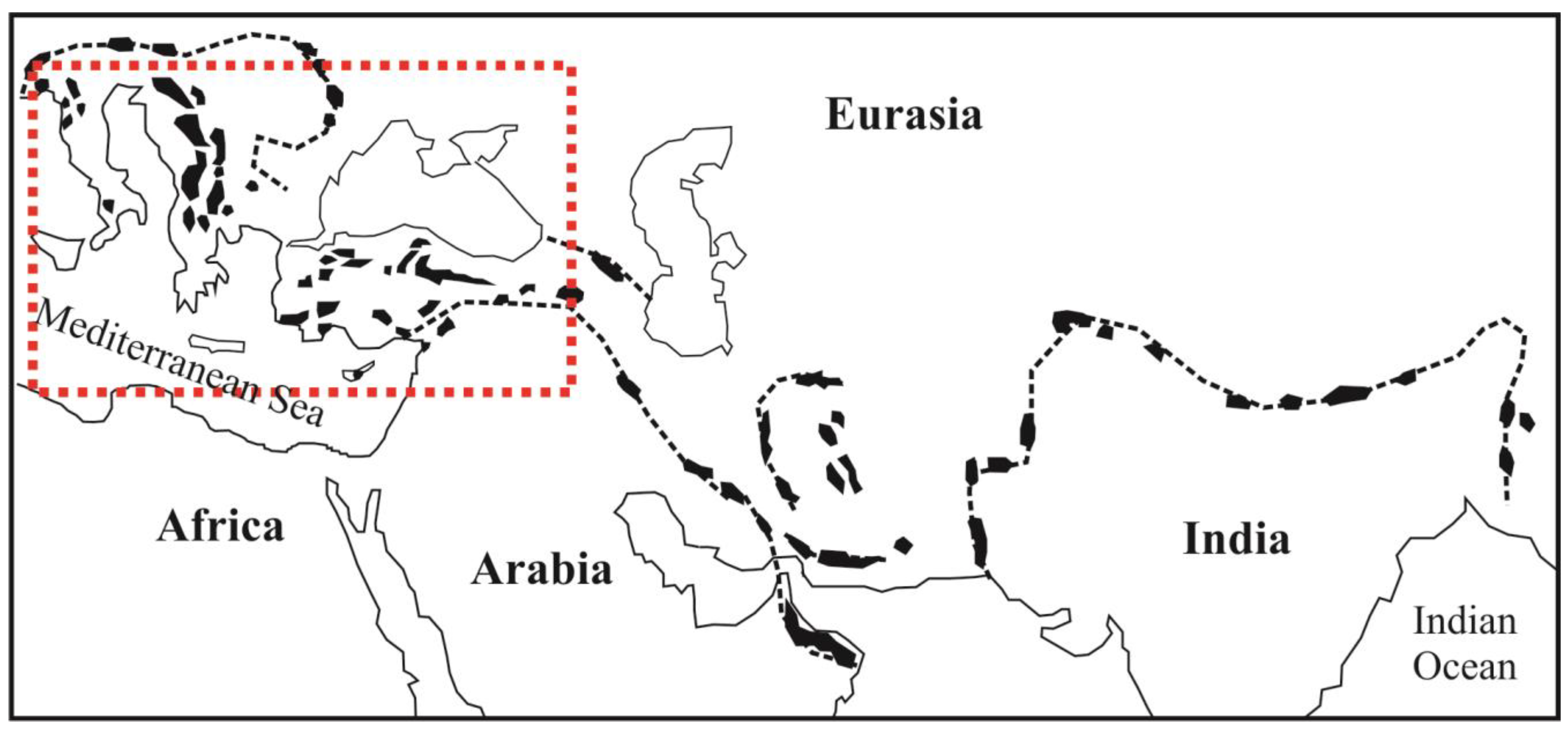
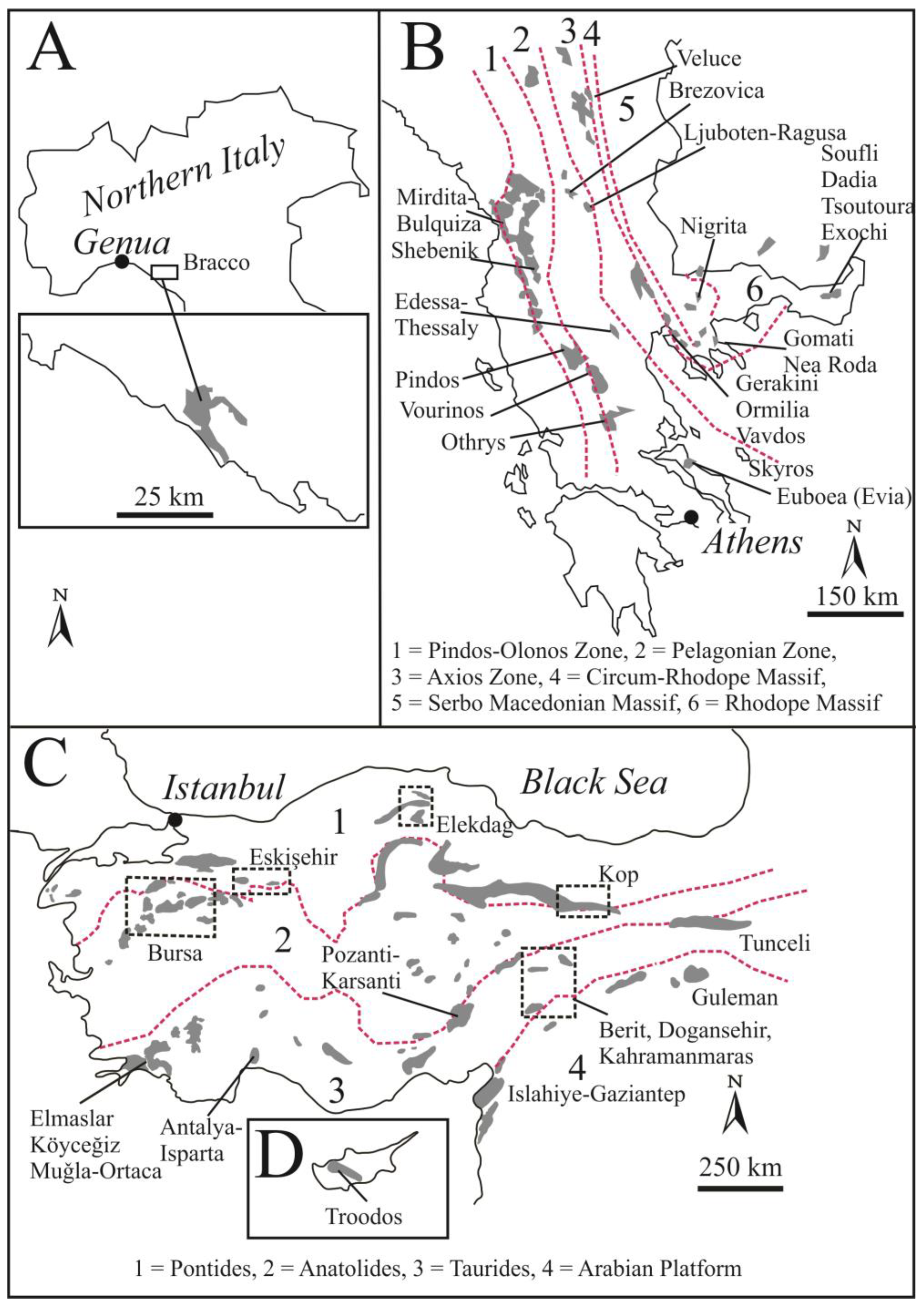

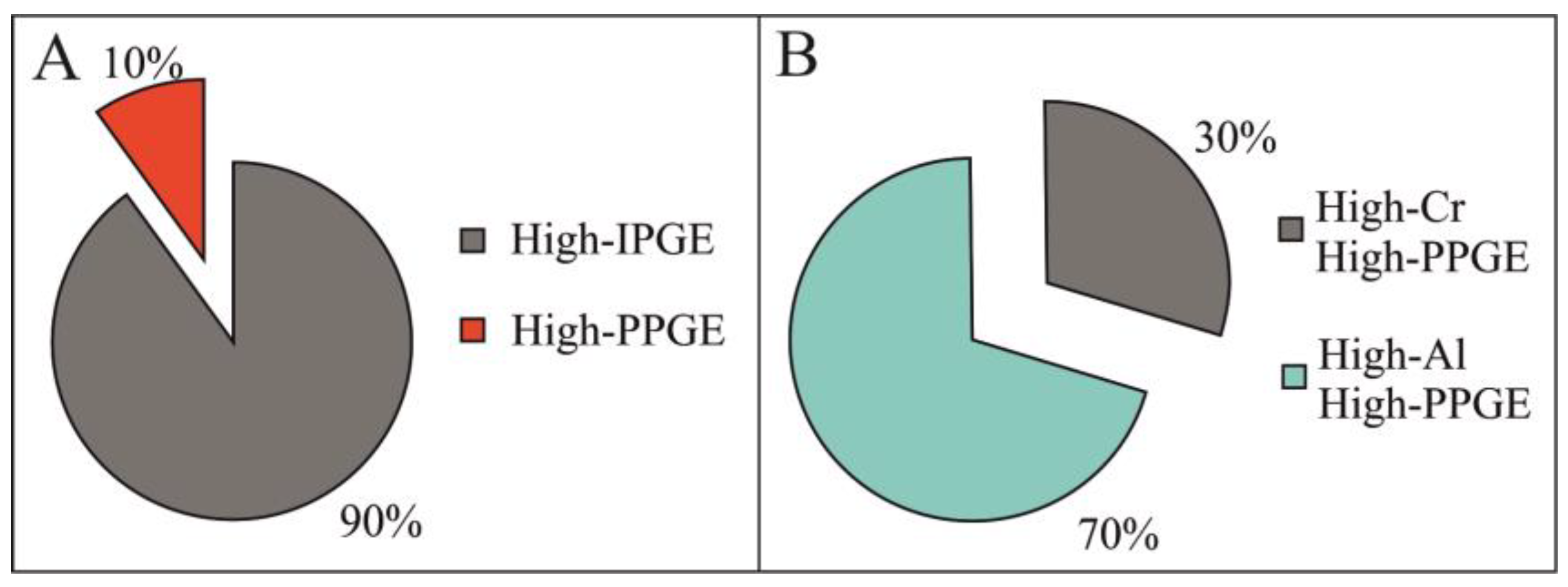
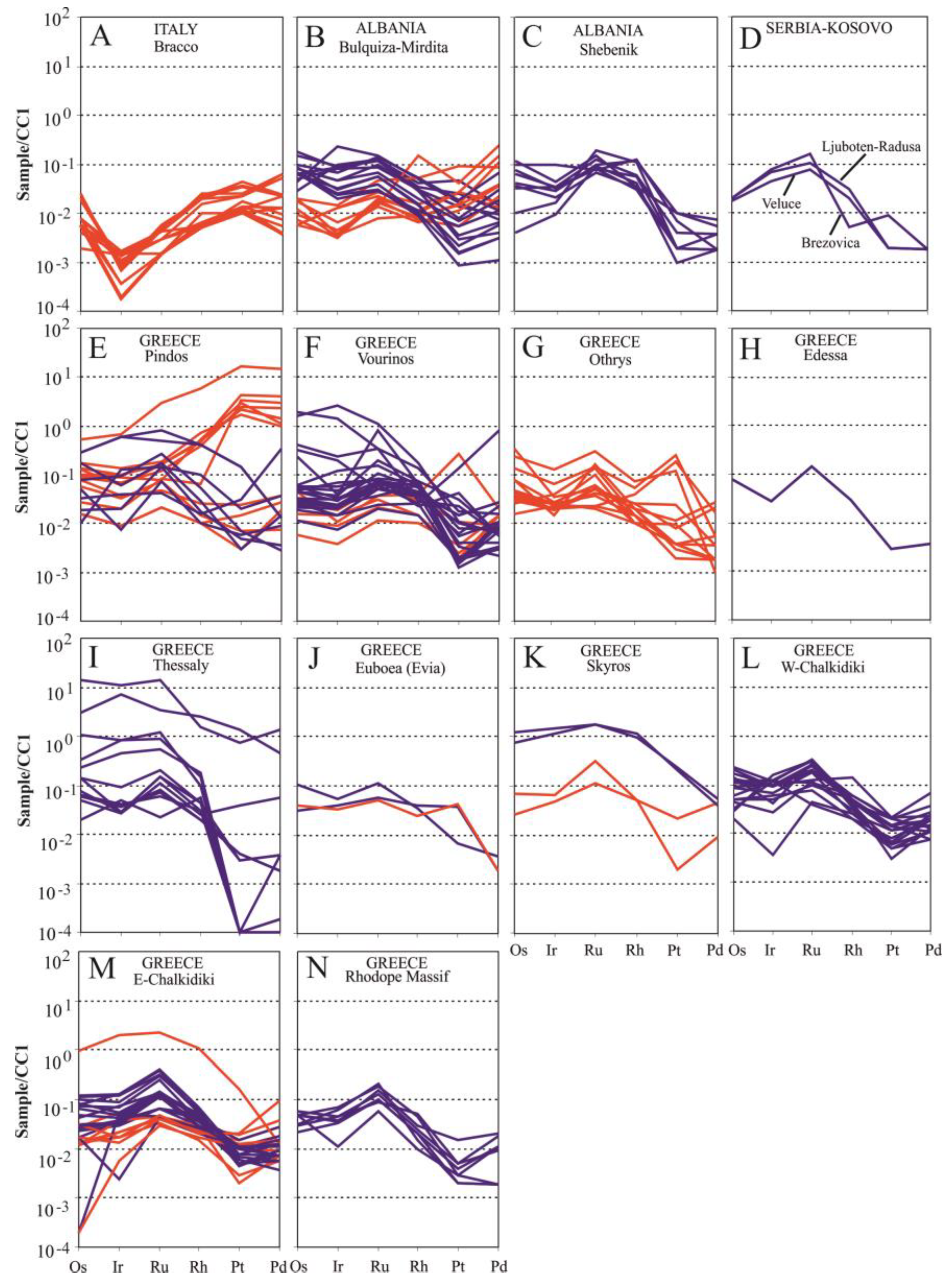
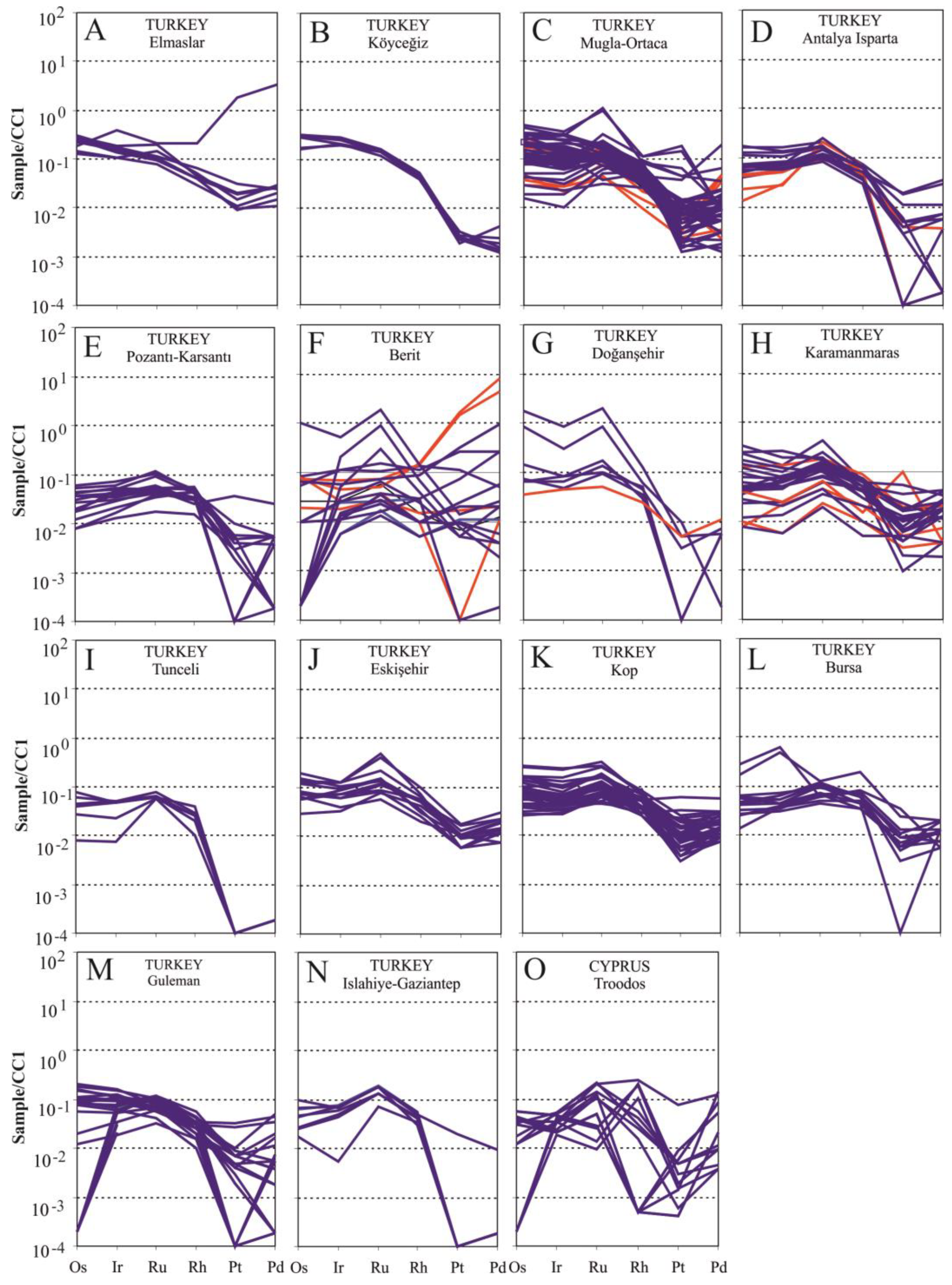
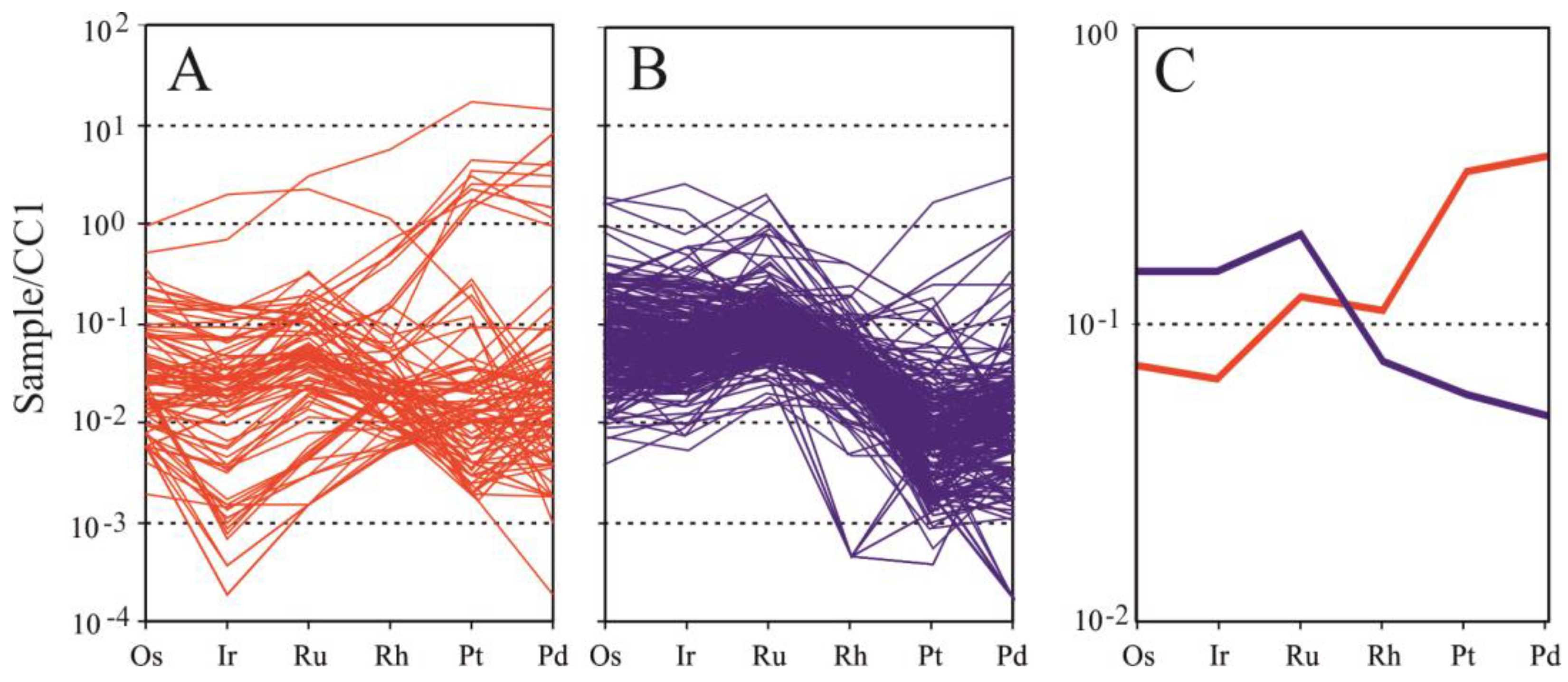
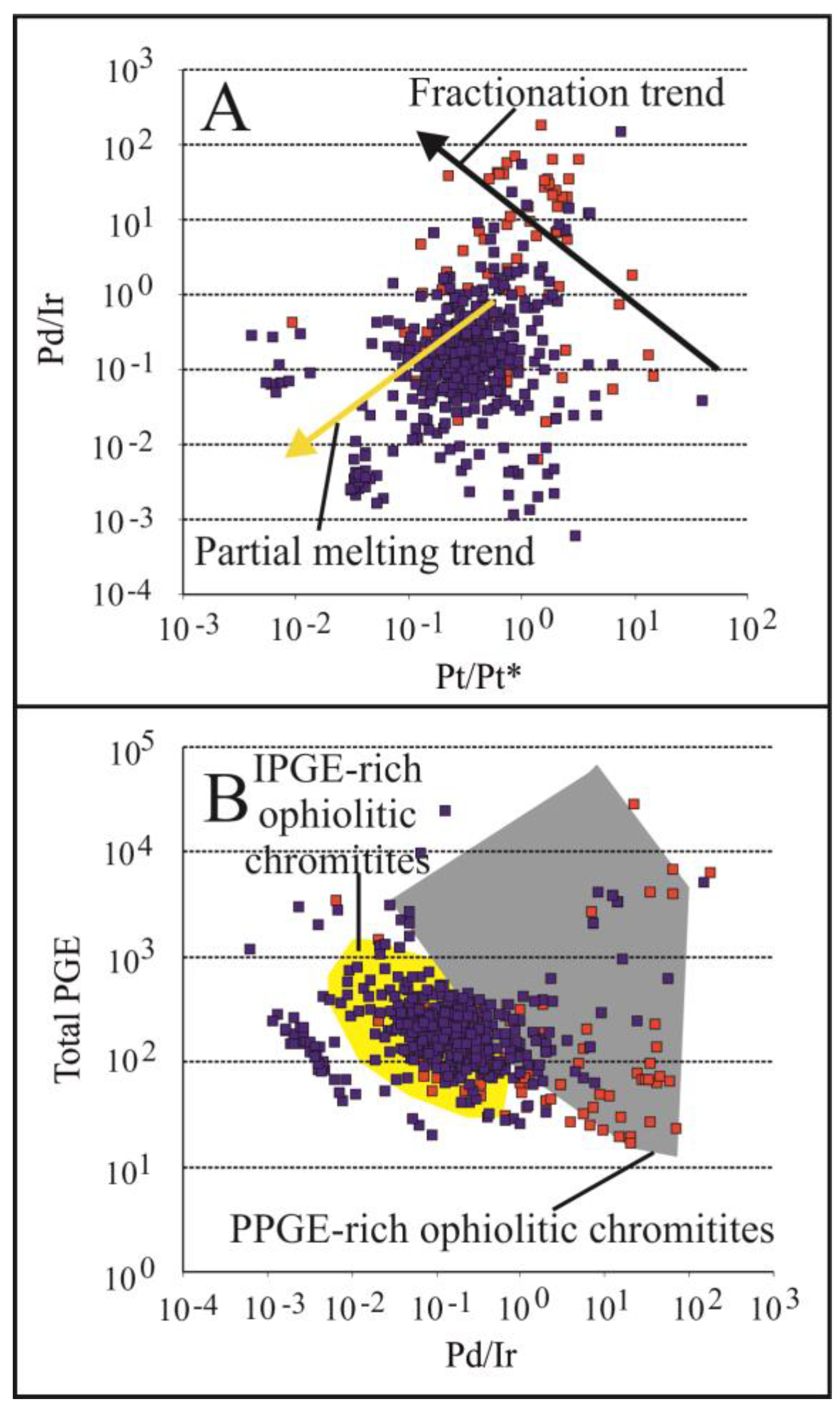
| Country | Ophiolite | Tectonic Unit | Name of the Deposit | Stratigraphy | Host Peridotite | Chromite Type | References |
|---|---|---|---|---|---|---|---|
| ITALY | Bracco | Internal Ligurides | Lherzolite | [21] | |||
| Canegreca, Cima Stronzi, | Mantle–cumulate | High-Al | |||||
| Mattarana, | |||||||
| Pian della Madonna, Ziona | |||||||
| SERBIA | Veluce | Axios Zone | Veluce | Mantle | Lherzolite–harzburgite–dunite | High-Cr | [34] |
| ALBANIA | Mirdita–Bulqiza | Pindos–Olonos Zone | Harzburgite | [35,36,37] | |||
| Bulqiza | Mantle–MTZ | High-Cr | |||||
| Bulqiza-Ceruja | Mantle–MTZ | High-Al | |||||
| Bulqiza-Bater | Mantle | High-Cr | |||||
| Bulqiza-Qaf Dardhe | MTZ | High-Al | |||||
| Shebenik | Pindos–Olonos Zone | Mantle–MTZ | Harzburgite | High-Cr | [38] | ||
| GREECE | Pindos | Pindos–Olonos Zone | Harzburgite–dunite | [32,39,40,41,42,43,44] | |||
| Dramala | Mantle | High-Cr | |||||
| Kambos Despoti | Mantle | High-Cr | |||||
| Kyra Kali | Mantle | High-Cr | |||||
| Korydallos-Gournes | Mantle–MTZ–cumulate | High-Al, High-Cr | |||||
| Milia | Mantle | High-Cr | |||||
| Trygona | Mantle | High-Cr | |||||
| Vourbiani | Mantle | High-Al | |||||
| Vourinos | Western side of the Pelagonian Zone | Harzburgite–dunite | [34,39,45,46,47,48,49] | ||||
| Aetoraches | Mantle | High-Cr | |||||
| Doumarachi | Mantle | High-Cr | |||||
| Kissavos | Mantle–MTZ | High-Al, High-Cr | |||||
| Kondro | Mantle | High-Cr | |||||
| Keratsista | Mantle | High-Cr | |||||
| Koursumia | Mantle | High-Cr | |||||
| Mikroklisoura | Mantle–MTZ | High-Cr | |||||
| Pefka | Mantle | High-Cr | |||||
| Rizo | Mantle | High-Cr | |||||
| Rodiani-Zygosti | Mantle | High-Al | |||||
| Tsouka | Mantle | High-Cr | |||||
| Voidolakkos | Mantle | High-Cr | |||||
| Xerolivado | Mantle | High-Cr | |||||
| Othrys | Pelagonian Zone | Lherzolite | [32,39,50,51] | ||||
| Agio Stefanos | Mantle | High-Al | |||||
| Domokos | Mantle | High-Al | |||||
| Eretria-Tsangli | Mantle | High-Al | |||||
| Edessa | Pelagonian Zone | Edessa | Mantle | Harzburgite | High-Cr | [34] | |
| Thessaly | Pelagonian Zone | Harzburgite–lherzolite | [25,32,34,52] | ||||
| Fitia | Mantle | High-Cr | |||||
| Giannakochori | Mantle | High-Cr | |||||
| Mavrolivado | Mantle | High-Cr | |||||
| Veria (Galaktos) | Mantle | High-Cr | |||||
| Vermion | Mantle | High-Cr | |||||
| Euboea (Evia) | Pelagonian Zone | Harzburgite | [34] | ||||
| Madoudi | Mantle | High-Al, High-Cr | |||||
| Nea Artaki | Mantle | High-Cr | |||||
| Skyros | Pelagonian Zone | Harzburgite | [32,34,45,53] | ||||
| Achladones | Mantle | High-Al | |||||
| Agios Iannis | Mantle | High-Cr | |||||
| Western Chalkidiki | Circum-Rhodope Belt | Harzburgite–dunite | [25,32,34,54,55,56] | ||||
| Gerakini | Mantle | High-Cr | |||||
| Ormilia | Mantle | High-Cr | |||||
| Vavdos | Mantle | High-Cr | |||||
| Eastern Chalkidiki | Serbo Macedonian Massif | Harzburgite | [25,34,54,57,58] | ||||
| Gomati (Paivouni, Tripes | Mantle | High-Al, High-Cr | |||||
| Agios Georgios, Kroupnos, | |||||||
| Limonadika) | |||||||
| Nigrita | Mantle | High-Cr | |||||
| Nea Roda | High-Al, High-Cr | ||||||
| Rhodope Massif | Rhodope Massif | Harzburgite–dunite | |||||
| Dadia | Mantle | High-Cr | [34] | ||||
| Exochi | Mantle | High-Cr | |||||
| Soufli | Mantle | High-Cr | |||||
| Tsoutoura | Mantle | High-Al | |||||
| KOSOVO | Brezovica | Pelagonian Zone | Mantle | Harzburgite–dunite | High-Cr | [34] | |
| Ljuboten–Radusa | Pelagonian Zone | Mantle | Harzburgite | High-Cr | [34] | ||
| TURKEY | Elmaslar | Western Taurides, Lycian Nappe | Mantle | Harzburgite | High-Cr | [67] | |
| Köyceğiz | Western Taurides, Lycian Nappe | Mantle | Harzburgite | High-Cr | [68] | ||
| Muǧla–Ortaca | Western Taurides, Lycian Nappe | Catal, Sandalbasi, Bulusblu, | Mantle | Harzburgite–dunite | High-Al, High-Cr | [69,70,71,72] | |
| Zeytinli, Payamli | |||||||
| Antalya–Isparta | Central–Western Taurides, Antalya Suture Zone | Mantle | Harzburgite | High-Al, High-Cr | [59] | ||
| Pozanti–Karsanti | Eastern Taurides | Kızılyüksek | Mantle–MTZ–cumulate | Harzburgite | High-Cr | [66] | |
| Berit | Eastern Taurides | Palith | Mantle | Harzburgite | High-Al, High-Cr | [60,61] | |
| Alish, Dereağzı, Kırcıuşağı, | MTZ–cumulate | ||||||
| Payamly, Sarıkat | |||||||
| Doğanşehir | Eastern Taurides | Mantle | Harzburgite | High-Al, High-Cr | [61] | ||
| Kahramanmaras | Eastern Taurides | Adiyaman, Elbistan, | Mantle | Harzburgite | High-Al, High-Cr | [65] | |
| Heikimhan, Kara, Malatya | |||||||
| Turkoglu | |||||||
| Tunceli | Eastern Taurides, Izmir–Ankara–Erzincan Suture Zone | Yıldırım, Aksu, Hasangazi, | Mantle | Harzburgite | High-Cr | [77] | |
| Atilla, Eskigedik, Işıkvuran, | |||||||
| Oymadal | |||||||
| Eskişehir | Pontides, Izmir–Ankara–Erzincan Suture Zone | Daǧküplü, Kavak | Mantle | Harzburgite | High-Cr | [75] | |
| Elekdaǧ | Pontides, Sakarya Zone | Mantle | Harzburgite–dunite | High-Al, High-Cr | [74] | ||
| Kop | Pontides, Erzincan–Erzurum | Bal,Çalışkan, Engin, Ezan, | MTZ | Harzburgite | High-Cr | [76] | |
| G. Bülent, Gözeler, Gürel, | |||||||
| Irem, K. Bülent, Kurtaran, | |||||||
| Okutan, Selin, Sulu | |||||||
| Bursa–Harmancık | Anatolides, Izmir–Ankara–Erzincan Suture Zone | Mantle | Dunite | High-Cr | [73] | ||
| Bursa–Orhaneli | Anatolides, Izmir–Ankara–Erzincan Suture Zone | Mantle | Dunite | High-Cr | [73] | ||
| Guleman | Arabian Platform, Elazig Zone | Bati Kef, Alacakaya | Mantle | Harzburgite–dunite | High-Cr | [62,63] | |
| Islahiye–Gaziantep | Arabian Platform, Bitlis–Zagros Suture Zone | Mantle | Harzburgite–dunite | High-Cr | [64] | ||
| CYPRUS | Troodos | Taurides | Hadji Pavlou | Mantle | Harzburgite | High-Cr | [78,79,80] |
| Kannoures | Cumulate | Harzburgite–dunite | High-Cr | ||||
| Kokkinorotsos | Cumulate | Harzburgite–dunite | High-Cr | ||||
| Mantle | Harzburgite | High-Cr | |||||
| Mantle | High-Cr | ||||||
| Mantle | High-Cr |
| Os | Ir | Ru | Rh | Pt | Pd | ΣPGE | Pd/Ir | Pt/Pt* | PPGE/IPGE | |
|---|---|---|---|---|---|---|---|---|---|---|
| High-Al | ||||||||||
| Average | 37 | 35 | 84 | 22 | 329 | 199 | 512 | 9.67 | 1.36 | 3.14 |
| Minimum | - | - | 1 | 1 | - | 1 | 17 | - | 0.01 | 0.02 |
| Maximum | 481 | 1080 | 2100 | 1140 | 17,100 | 7860 | 28,830 | 178.60 | 14.42 | 61.39 |
| High-Cr | ||||||||||
| Average | 77 | 81 | 138 | 15 | 59 | 26 | 396 | 1.03 | 0.64 | 0.66 |
| Minimum | - | 1 | - | - | - | - | 20 | - | - | 0.01 |
| Maximum | 7400 | 6020 | 9700 | 510 | 3460 | 1815 | 24,940 | 150.91 | 39.21 | 62.6 |
Disclaimer/Publisher’s Note: The statements, opinions and data contained in all publications are solely those of the individual author(s) and contributor(s) and not of MDPI and/or the editor(s). MDPI and/or the editor(s) disclaim responsibility for any injury to people or property resulting from any ideas, methods, instructions or products referred to in the content. |
© 2024 by the authors. Licensee MDPI, Basel, Switzerland. This article is an open access article distributed under the terms and conditions of the Creative Commons Attribution (CC BY) license (https://creativecommons.org/licenses/by/4.0/).
Share and Cite
Zaccarini, F.; Economou-Eliopoulos, M.; Tsikouras, B.; Garuti, G. Chromite Composition and Platinum-Group Elements Distribution in Tethyan Chromitites of the Mediterranean Basin: An Overview. Minerals 2024, 14, 744. https://doi.org/10.3390/min14080744
Zaccarini F, Economou-Eliopoulos M, Tsikouras B, Garuti G. Chromite Composition and Platinum-Group Elements Distribution in Tethyan Chromitites of the Mediterranean Basin: An Overview. Minerals. 2024; 14(8):744. https://doi.org/10.3390/min14080744
Chicago/Turabian StyleZaccarini, Federica, Maria Economou-Eliopoulos, Basilios Tsikouras, and Giorgio Garuti. 2024. "Chromite Composition and Platinum-Group Elements Distribution in Tethyan Chromitites of the Mediterranean Basin: An Overview" Minerals 14, no. 8: 744. https://doi.org/10.3390/min14080744







